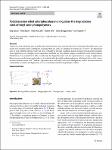Item Infomation
Full metadata record
| DC Field | Value | Language |
|---|---|---|
| dc.contributor.author | Edip, Ajvazi | - |
| dc.contributor.author | Felix, Bauer | - |
| dc.contributor.author | Milan, Kracalik | - |
| dc.date.accessioned | 2023-04-20T09:04:08Z | - |
| dc.date.available | 2023-04-20T09:04:08Z | - |
| dc.date.issued | 2023 | - |
| dc.identifier.uri | https://link.springer.com/article/10.1007/s00706-023-03042-x | - |
| dc.identifier.uri | https://dlib.phenikaa-uni.edu.vn/handle/PNK/8171 | - |
| dc.description | CC BY | vi |
| dc.description.abstract | Vinyl esters and carbonates have recently been demonstrated to have considerably lower cytotoxicity than their more commonly used (meth)acrylate counterparts, inspiring their use in the 3D printing of biomaterials. However, the degradation rates of such synthetic photopolymers are slow, especially in the mild conditions present in many biological environments. Some applications, for example, tissue regeneration scaffolds and drug release, require considerably faster biodegradation. Furthermore, it is essential to be able to easily tune the degradation rate to fit the requirements for a range of applications. Herein we present the design and synthesis of hydrolytically degradable polyphosphazenes substituted with a vinyl carbonate functionalized amino acid. Thiolene copolymerization with vinyl esters gave cured polymers which are demonstrated to considerably accelerate the degradation rates of cured vinylester/thiolene polymer scaffolds. | vi |
| dc.language.iso | en | vi |
| dc.publisher | Springer | vi |
| dc.subject | (meth)acrylate counterparts | vi |
| dc.subject | 3D printing of biomaterials | vi |
| dc.title | Poly[bis(serine ethyl ester)phosphazene] regulates the degradation rates of vinyl ester photopolymers | vi |
| dc.type | Book | vi |
| Appears in Collections | ||
| OER - Khoa học Tự nhiên | ||
Files in This Item:

